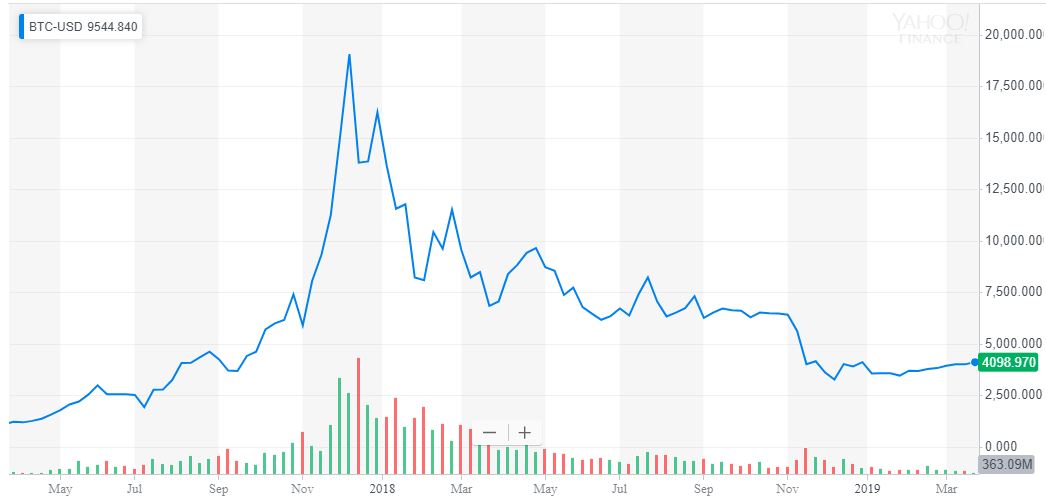By CCN.com: Erik Voorhees, the founder and CEO of ShapeShift, a leading crypto conversion platform, has said crypto is maturing and that despite the price trend of bitcoin and other major crypto assets, the industry has seen growth in key areas in recent months.
Crypto is maturing. It is now firmly in its adolescence.
— Erik Voorhees (@ErikVoorhees) March 29, 2019
In the past 15 months, the valuation of the crypto market has plunged from $813 billion to $143 billion, by 82 percent, and exchanges have seen an overall decline in daily volume.
Yet, industry executives remain positive on the medium to long-term growth of the cryptocurrency industry amidst its longest-ever bear market.
What’s There to be Positive About in Crypto? And Will Bitcoin Reflect?
From January to March, within a 3-month span, the crypto market has arguably seem more progress in institutionalization than in the past 9 years from 2009 to 2018.
Under the guidance of Morgan Creek Digital, the first batch of institutional investors including public U.S. pension funds, a hospital, and an insurance company invested in the crypto market.
On Wednesday, BlockTower Capital co-founder Ari Paul said that Fidelity, one of the world’s largest asset managers with $2.46 trillion in assets under management, has hundreds of employees enthusiastic about crypto at every executive level.
“Fidelity’s cryptocurrency culture is bonkers. Literally hundreds of passionate advocates at every level of seniority at the firm. They have more people working on crypto than the 5 biggest crypto funds combined. Their approach to custody from a security perspective is very impressive (at least from my relatively quick look.) Not many groups actively mitigating things like HSM supply chain risk,” said Paul.
Institutional investors typically do not commit to emerging and under-regulated markets due to potential risks in liquidity and compliance.
Yet, in the case of crypto, asset managers like Fidelity are proactively building products like regulated custodial services, indices, and regulated futures markets to improve the liquidity in the cryptocurrency market.
I’d be extremely surprised if the bottom wasn’t in for this $BTC bear market.
If you’ve been on the sidelines, what are you waiting for if not now?
If you’re a long-term bull, the 5 year EV is 25-50x, and you’re going to wait to time an entry that’s 20% more attractive?
— Ryan Selkis (@twobitidiot) March 21, 2019
The bear market is an ideal period to test the resilience and strength of an industry or an asset class because it proves whether it is a fad or it has the ability to survive over the long run.
In March, Switzerland’s largest retailer Digitec Galaxus integrated bitcoin, Japan’s biggest railway operator announced its plans to integrate crypto assets as a payment option in the near-term, and a luxury hotel in Switzerland has started to accept bitcoin payments.
Swiss luxury hotel Dolder and @Ferrari dealer Kessel start accepting #Bitcoin, using our new PoS app inapay.#Bitcoin is back as a medium of exchange.https://t.co/WpqAZvKJNM
— Lucas Betschart (@lucas_lclc) March 27, 2019
More conglomerates in the likes of SBI Holdings and Yahoo! Japan have started to commit to the cryptocurrency sector, operating mining businesses and cryptocurrency exchanges.
Market data providers and investment firms have stopped dismissing the fake volume plague in the cryptocurrency market and have begun to push for the expulsion of wash trading from prominent exchanges.
The cryptocurrency market is well structured and more regulated than ever, indicating that despite the 15-month bear market and the 85 percent correction of bitcoin, companies have continued to build and improve the infrastructure supporting cryptocurrencies as an asset class.
Why the Bitcoin Price is Stuck in Neutral


The crypto industry’s phenomenal growth has not yet manifested in the bitcoin price. | Source: Yahoo Finance
Often, industry executives have said that the bear market is crucial for building because it allows companies to step back from the frenzy, reflect, and evaluate areas of improvement.
The intense sell-off of crypto assets has allowed quality companies to remain and poor projects to filter out, strengthening the ecosystem and the overall state of the market.
If a new wave of either institutional investors or retail investors come into the cryptocurrency market in the future, possibly in the fourth quarter of 2019 as some strategists have projected, then the prices of crypto assets could reflect.
For now, it is difficult to expect the price of bitcoin to move as it did in late 2017 – but the industry’s continued growth nevertheless remains a wildly bullish signal.


